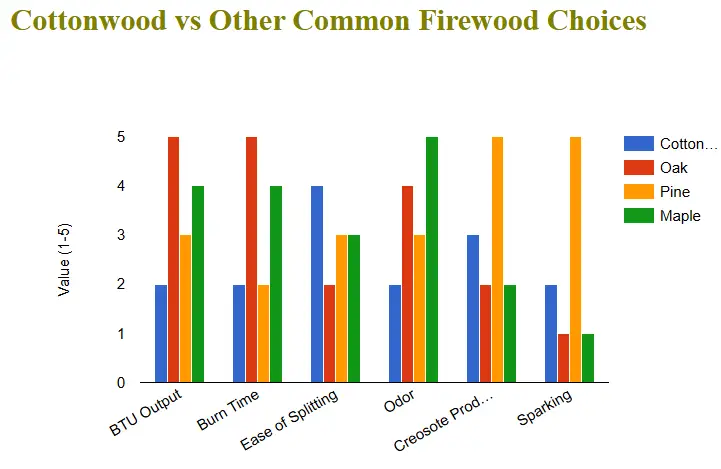If you’re wondering whether Cottonwood makes for good firewood, you’ve probably heard mixed reviews. Some people swear by its easy splitting and availability, while others complain about its low heat output and faster burn rate.
So, is Cottonwood worth burning in your fireplace or outdoor fire pit?
Let’s dive deep into the pros and cons and see how it compares to other popular firewood options.
Is Cottonwood Good Firewood?
Cottonwood firewood is a moderately good choice for burning, offering approximately 15.8 to 16.8 million BTUs per cord. While it burns quickly and is easy to split when seasoned, it requires about 6 to 12 months of drying time for optimal performance.
Cottonwood produces a medium amount of smoke, especially if not fully seasoned, and has moderate creosote buildup compared to softer woods like pine.
Although its lower heat output makes it less ideal for extremely cold weather, it serves well as kindling or during shoulder seasons.
Overall, cottonwood can be a practical option when used in combination with denser hardwoods for better heat retention.
Cottonwood Key Stats
Overview
| Feature | Description |
|---|---|
| BTU Output (Million BTU/Cord) | Low heat output compared to denser woods. |
| Coal Production | Produces minimal coals, requiring frequent refueling. |
| Smoke Production | Moderate smoke; may cause buildup if not seasoned well. |
| Ease of Splitting | Relatively easy to split, especially when dry. |
| Ease of Seasoning | Dries quickly, making it good for short-term use. |
| Fragrance | Minimal to no pleasant aroma when burning. |
| Burn Duration | Burns quickly, requiring constant attention. |
Types of Cottonwood Trees
-
Eastern Cottonwood: Found in the eastern and central U.S., this species grows rapidly and can reach enormous sizes.
-
Black Cottonwood: Native to the western U.S., it’s often found along rivers.
-
Fremont Cottonwood: Common in the southwestern regions and recognized for its heart-shaped leaves.
Properties of Cottonwood as Firewood
Freshly cut Cottonwood has a high moisture content, making it heavy and challenging to burn until properly seasoned. It’s also a lightweight wood once dried, which impacts its heat output.
The BTU (British Thermal Unit) rating of Cottonwood is around 15.8-16.8 million BTUs per cord, which is relatively low compared to hardwoods like oak (24-26 million BTUs).
Pros of Using Cottonwood as Firewood
-
Cottonwood is widely available across the U.S. and is often inexpensive or even free if sourced from fallen trees.
-
When dry, Cottonwood is relatively easy to split, making it user-friendly for those who cut their own firewood.
-
Cottonwood produces minimal creosote buildup, which reduces the risk of chimney fires when compared to resinous woods like Pine.
Cons of Cottonwood Firewood
-
Cottonwood’s low BTU rating means it doesn’t provide as much heat as denser woods like oak or maple, making it less ideal for long winter heating.
-
Fresh Cottonwood is heavy with water, and if burned green, it will sizzle and smoke excessively.
-
Even when seasoned, Cottonwood burns faster than hardwoods, meaning you’ll need to feed the fire more frequently.
-
Green Cottonwood can emit a sour, unpleasant smell. Proper seasoning is essential to avoid this issue.
Cottonwood vs Other Common Firewood Choices
How to Properly Season Cottonwood Firewood
Seasoning reduces the moisture content in Cottonwood, improving its burn efficiency and preventing smoke issues.
- Split the wood into small pieces.
- Stack it in a crisscross pattern to allow airflow.
- Store the wood off the ground, covered but with good ventilation.
- Let it dry for 6-12 months for optimal results.
Cottonwood typically takes at least 6 months to dry properly, but in humid climates, it could take up to a year. Use Cottonwood alongside oak or maple for longer, hotter burns.
Signs That Cottonwood Is Ready to Burn
-
Moisture Level: Use a moisture meter; aim for below 20%.
-
Sound: Dry Cottonwood produces a hollow sound when knocked together.
-
Appearance: Cracks on the ends indicate it’s dry.
How to Identify Cottonwood Trees for Firewood Harvesting
-
Heart-shaped leaves with serrated edges.
-
Fluffy seeds in late spring.
-
Smooth bark on younger trees and deeply furrowed bark on older ones.
FAQs
Is Cottonwood a hardwood or softwood?
Cottonwood is classified as a hardwood, though it’s relatively soft compared to other hardwoods.
Does Cottonwood burn hotter than Pine?
No, Pine burns slightly hotter but creates more creosote.
Can you use Cottonwood in a wood stove?
Yes, but it’s best to mix it with hardwood for better heat output.
How do you reduce the odor of burning Cottonwood?
Proper seasoning eliminates most unpleasant smells.
Is Cottonwood firewood safe for cooking?
While it’s safe, it’s not ideal due to its mild odor. Hardwoods like oak are better for cooking.


Affiliate Disclosure: Fireplaceadviser.com is a participant in the Amazon Services LLC Associates Program. We may earn a commission when you click on certain links on this site and purchase.

Hello!! I am Jamal Khan. I often fix my home electric heaters and gas stove problems and research the common issues in the heating units to improve my knowledge and expertise. The aim of establishing fireplaceadviser.com is to share my expertise and knowledge with my audience.


















